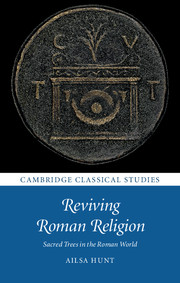Book contents
- Frontmatter
- Dedication
- Contents
- List of figures
- Acknowledgements
- 1 Rooting in: why give time to sacred trees?
- 2 A brief history of tree thinking: the enduring power of animism
- 3 How arboreal matter matters: rethinking sacrality through trees
- 4 Arboriculture and arboreal deaths: rethinking sacrality again
- 5 Confronting arboreal agency: reading the divine in arboreal behaviour
- 6 Imagining the gods: how trees flesh out the identity of the divine
- 7 Branching out: what sacred trees mean for Roman religion
- Appendix
- Bibliography
- Index
7 - Branching out: what sacred trees mean for Roman religion
Published online by Cambridge University Press: 05 September 2016
- Frontmatter
- Dedication
- Contents
- List of figures
- Acknowledgements
- 1 Rooting in: why give time to sacred trees?
- 2 A brief history of tree thinking: the enduring power of animism
- 3 How arboreal matter matters: rethinking sacrality through trees
- 4 Arboriculture and arboreal deaths: rethinking sacrality again
- 5 Confronting arboreal agency: reading the divine in arboreal behaviour
- 6 Imagining the gods: how trees flesh out the identity of the divine
- 7 Branching out: what sacred trees mean for Roman religion
- Appendix
- Bibliography
- Index
Summary
Contrary to appearances, this book is not all about trees. For the significance of the trees we have met, and the theological questions they raise, spill out into our wider understanding of Roman religion. Trees have plenty to say, for example, about Roman understandings of sacrifice. Sensitivity to prepositions displayed by the fratres Arvales as they sacrificed because a tree had died has shown us that Roman thinkers might sacrifice about a situation, rather than to a deity; their pruning sacrifices too have challenged our understanding of piacula as atonement for unwitting faults. Trees have also enriched our knowledge of Roman thinking about statues of the divine: at Corinth, making statues of Dionysus from a tree was a way of worshipping that tree, along with the god; at Delphi a hybrid Athena-cum-palm articulated something essential about Athena's identity. To throw out a few more examples, the fig which prompted the coining of Adolenda Conmolenda Deferunda has shown us that there is nothing simplistic about Sondergötter. An oak beloved of Atalanta (among other trees) has urged us to rethink our understanding of the word numen. A palm which sprang up on an altar at Tarraco has revealed how engaging in imperial cult can raise challenging questions about an emperor's self-knowledge. Trees have long stood at the edge of the field in scholarship on Roman religion, but their ability to prompt Roman thinking about multiple aspects of their religious practices and the nature of the divine demands that they be rooted in the centre.
Moreover, as soon as trees are allowed to take a centre-stage position within our portraits of Roman religion, they urge us to revive those portraits in two major ways. Firstly, trees urge us to discard the inflexible legalistic definitions of ‘sacrality as consecration’ so dominant in current scholarship. The trees encountered in this book have insisted that their sacrality is far too diverse and multi-layered to be forced into such a model. Rather we have seen that Roman thinkers engaged with trees as sacred by placing a palm shoot among their penates, by sacrificing to Adolenda Coinquenda, preserving the remains of a plane in a temple, calling Jupiter ‘Fagutalis’ or commissioning an image of Hercules hugging a tree.
- Type
- Chapter
- Information
- Reviving Roman ReligionSacred Trees in the Roman World, pp. 292 - 294Publisher: Cambridge University PressPrint publication year: 2016



